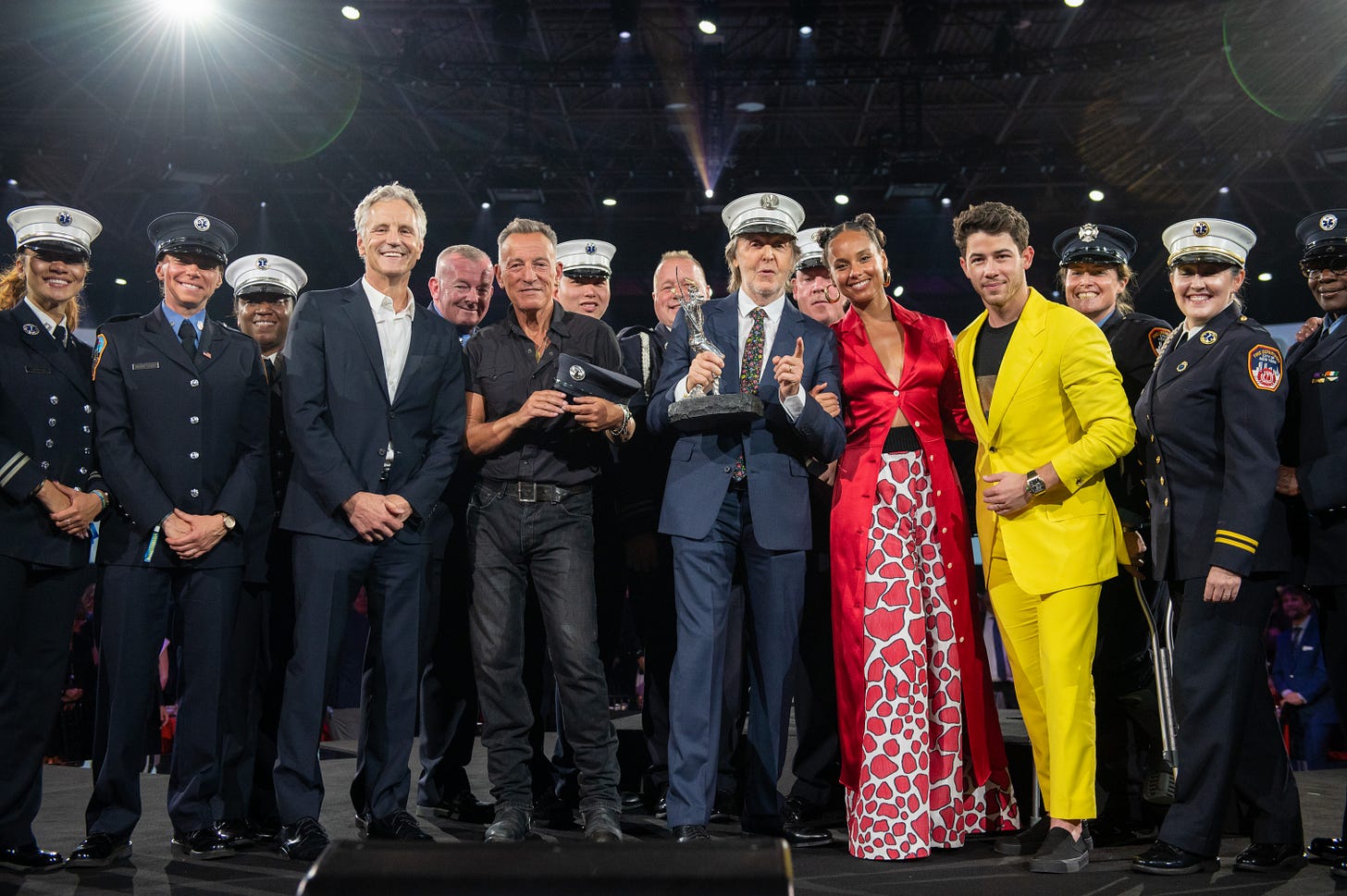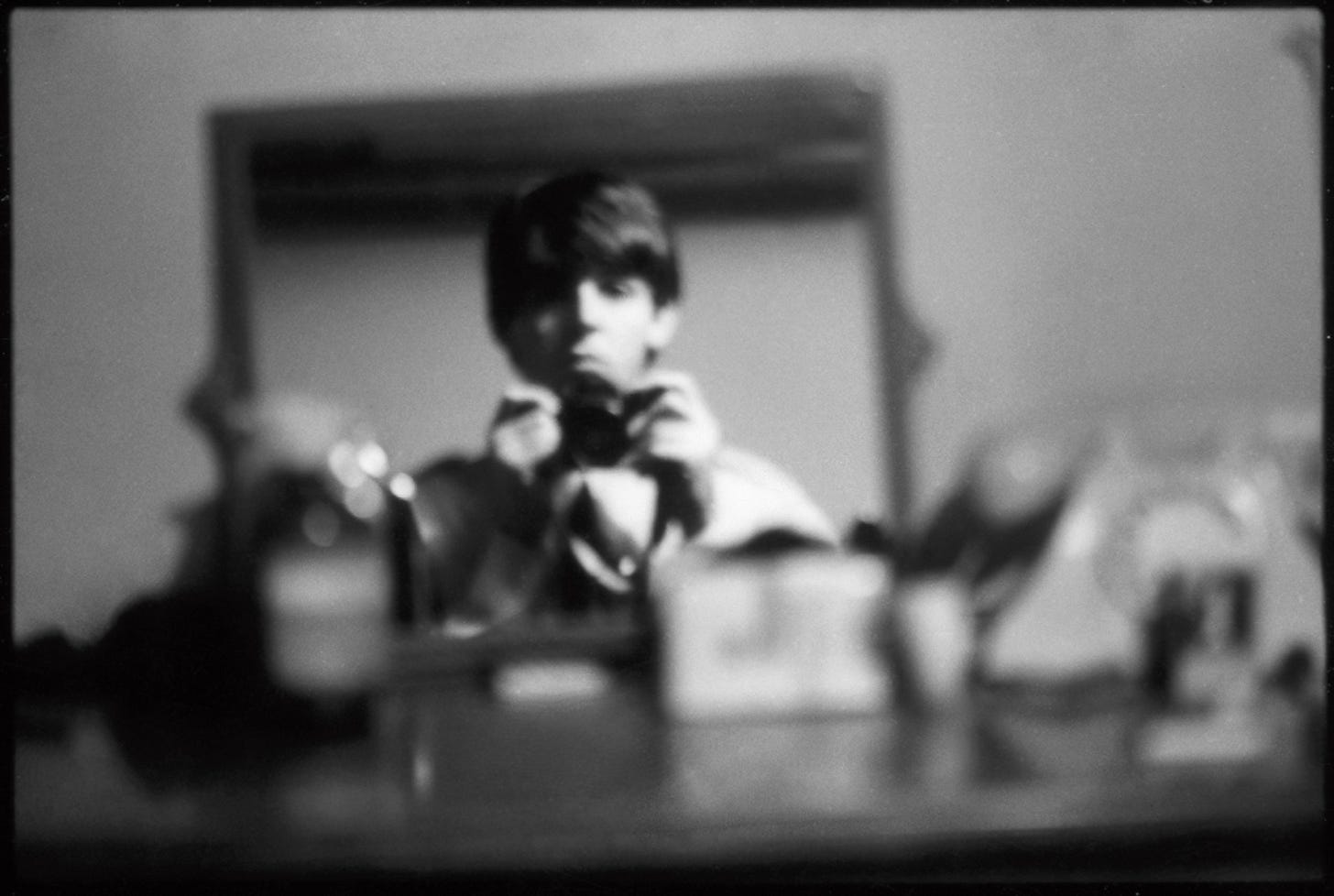not for your ears only: alicia keys, swizz beatz, and paul mccartney at the brooklyn museum
Paul McCartney and Alicia Keys team up with an all-star lineup at the 2021 Robin Hood benefit (photo courtesy Robin Hood)
Alicia Keys and Paul McCartney are together again, although in an unexpected way.
My first concert was Paul McCartney & Wings at Madison Square Garden in 1976; my father took me for my thirteenth birthday, and we had great seats for the spectacular three-hour show. That was only part of my present; for the next twelve months, my amazing dad took me once a week to Korvette’s to buy one album, so by the end of that time I had fifty-two records, including every official release by the Fab Four as well as by the Cute One as a solo act and with Wings.
The next year, my parents took me, my younger brother, and my younger sister to the Winter Garden Theatre to see my first Broadway musical, Beatlemania, which was billed as “Not the Beatles, but an incredible simulation.” It was, naturally, incredible to fourteen-year-old me.
About a decade ago, I was walking west on Fifty-Sixth St. in a very light rain when I saw a small group of people coming toward me; in the middle was a familiar face, under a white umbrella he was holding up.
“Good afternoon, Sir Paul,” I said.
“Lovely to see you again,” he responded with a smile.
I had never met McCartney before; he was just being his usual charming self.
I have never met the Hell’s Kitchen born-and-raised Alicia Keys, and I don’t own any of her records. But I did thoroughly enjoy Stick Fly, the 2011 Broadway play she produced and composed the score for, and I love her semiautobiographical current Broadway musical, Hell’s Kitchen, which was nominated for thirteen Tonys and won two acting awards.
Keys, who has earned sixteen Grammys, and McCartney who has won eighteen along with an Oscar and an Emmy, have met each other, directly and indirectly, on numerous occasions. In 2011, Keys played an emotional version of McCartney’s “Blackbird” as part of “Piano & I: A One Night Only Event with Alicia Keys” and again at the February 2012 MusiCares Person of the Year gala honoring Paul. They posed for pictures at a Stella McCartney fashion show in Paris in March 2012. The all-star benefit “12-12-12: The Concert for Sandy Relief,” organized at the Garden by McCartney, concluded with a rousing rendition of Jay-Z and Keys’s “Empire State of Mind” that featured dozens of first responders and rock stars, with McCartney, the son of a volunteer fireman, front and center. At the 2014 Grammy Awards salute to the Beatles’ golden anniversary of appearing on The Ed Sullivan Show, Keys played “Let It Be” with John Legend as Sir Paul watched from the audience. And both McCartney and Keys participated at the 2021 Robin Hood Benefit at the Javits, raising money to help fight poverty.
Recently I caught different sides of Keys and McCartney in a pair of revelatory shows at the Brooklyn Museum.
“Giants: Art from the Dean Collection of Swizz Beatz and Alicia Keys,” on view through July 7, is a stunning exhibition of more than one hundred works owned by Keys and her husband, music producer, DJ, and rapper Kasseem Dean, aka Swizz Beatz. Divided into five sections — “Becoming Giants,” “On the Shoulders of Giants,” “Giant Conversations” (“Celebrating Blackness” and “Critiquing Society”), “Giant Presence,” and “Video Interviews” — the show highlights painting, sculpture, photography, and installation by such artists as Jordan Casteel, Nick Cave, Deana Lawson, Tschabalala Self, Lorna Simpson, Barkley Hendricks, Mickalene Thomas, Esther Mahlangu, Henry Taylor, and Ebony G. Patterson.
Derrick Adams’s Woman and Man in Grayscale is above a pair of silver DJ turntables. Arthur Jafa’s Big Wheel I, made of chains, a tire, a hubcap, and a rim, hangs from a gallows, evoking a slave lynching. Hank Willis Thomas’s Strike is a mirror-polished stainless-steel depiction of, according to Thomas, “an arm with a police baton attempting to strike another arm, which is holding that arm by the wrist.” There are several comfy listening stations for museumgoers to take a musical break.
“The mission of the Dean Collection is to collect, protect, and respect,” Keys says in an exhibition video. “The mission is also about being able to introduce our family, our kids, our loved ones to be able to see themselves on the wall, to be able to know our stories in much deeper ways.”
Kehinde Wiley’s portraits of Alicia Keys Dean and Kasseem Daoud Dean are part of “Giants” collection at Brooklyn Museum (photo by twi-ny/mdr)
There are portraits of Keys and Swizz Beatz by Kehinde Wiley, who painted the official portrait of President Barack Obama, and a diptych by Amy Sherald, who did First Lady Michelle Obama’s official portrait. Jamel Shabazz’s 2018 photograph of the Deans re-creates Gordon Parks’s 1970 photo of Black Panther leaders Eldridge and Kathleen Cleaver. One of Keys’s pianos is on display, the words love and freedom written across the top. Jarvis Boyland’s Pop Out painting of a man and a woman locking arms is echoed in a large-scale photo of the Deans. It’s a moving and personal show, by a pair of artists celebrating the work of other artists.
Another moving and personal show at the museum is the joyous “Paul McCartney Photographs 1963–64: Eyes of the Storm.”
About eighteen years before Alicia Augello Cook was born in New York City, Beatlemania was in its infancy.
Born in Liverpool in 1942, James Paul McCartney found himself in the midst of a musical revolution in 1963–64 as he, John Lennon, George Harrison, and Ringo Starr started touring Europe and, ultimately, the United States. The Brooklyn Museum show follows the Fab Four through the lens of McCartney’s Pentax camera as the band travels from Liverpool, London, and Paris to New York City, Washington, DC, and Miami. More than three hundred photographs, contact sheets, and related artifacts glory in the sheer jubilation the group experienced as it met its fans and the press and relaxed behind the scenes.
Paul McCartney, Self-portrait, London, 1963, large graphic reproduction (courtesy MPL Communications Ltd.)
“I think the value of these pictures is historical,” Macca says on the audioguide. “So I’m not setting out to be seen as a master photographer. Although I think they’re pretty good, I’m happy to just be thought of as an occasional photographer who happened to be in the right place at the right time.” He can be as humble as he wants, but the photos, which McCartney only recently unearthed with archivist Sarah Brown while exploring his late wife Linda’s work, prove he has an innate instinct regarding composition and perspective.
McCartney captured the playfulness of the band along with manager Brian Epstein, roadies Mal Evans and Neil Aspinall, producer George Martin, John’s wife Cynthia, Paul’s girlfriend Jane Asher, George’s parents and sister, French model Sophie Hardy, press officers Tony Barrow and Brian Sommerville, fan club secretary Freda Kelly, driver Bill Corbett, DJ Murray the K, photographers Robert Freeman and Harry Benson, and such supporting acts as the Vernons Girls, Clarence “Frogman” Henry, the Kestrels, Billy J. Kramer, and Cilla Black.
He took self-portraits in mirrors and pictures from planes, trains, and automobiles.
George wears a top hat on a top hat. Ringo is caught in the middle of a gleeful laugh, his hair sweeping to one side. A throng of press photographers furiously snaps away. The Fab Four pose with David Wynne’s clay busts of them. Ringo, John, and George put on goofy French chapeaux. George falls asleep on a plane. Police and airport staff wait for the band to disembark at Kennedy. Fans lurk at the Plaza Hotel. The band rehearses for Ed Sullivan.
But when the Moptops arrive in Miami for a brief vacation and head for the beach, Paul switches to a color camera as the band cavorts on the sand at the Deauville Hotel and at the home of Capitol Records executive Jerri Pollack. Many of the Miami photos have been blown up, immersing the viewer into the Beatles’ infectious world.
John swims in the ocean and the Pollacks’ pool. Neil sunbathes. Mal plays basketball. In one of Paul’s favorite photos, George, in sunglasses, relaxes poolside with a cigarette, accepting a drink from teenager Linda Pollack, who is in a yellow bikini. The band goes on a fishing trip.
Paul McCartney, George Harrison and Linda Pollack, chromogenic gloss print, 1964 (courtesy MPL Communications Ltd.)
It certainly looks like a good time was had by all, as evidenced by the short video McCartney made of the photos specifically for the exhibit.
“Paul McCartney Photographs 1963–64: Eyes of the Storm” is more than just a bunch of relics. Two years after these photos were taken, the Beatles would stop touring, and four years after that they broke up. The show celebrates the innocence of youth at a time of sweeping change in America, after the assassination of JFK and before the Vietnam War took hold of the nation.
But somehow, through it all, the magic created by a quartet of Liverpudlians still manages to lead us away from all our trials and tribulations, soothing our souls and lifting our spirits with every new discovery.





Great job, Mark! You’ve intertwined these great artists in a fabulously creative manner!! bravo!
What a wonderful review of 2 phenomenal exhibits!!! I also recommend that you do an Architectural Digest internet search for their video tour of Swizz/Alicia's amazing home in La Jolla, California where they keep a lot of their art on display. The video tour of their home, itself a work of art, overlooking the Pacific Palisades is truly amazing, and Alicia is just a doll hosting the tour.!!!